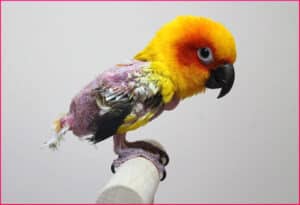
In the popular mind, a threat brings about two possible reactions: fight or flight. This is part of the stubborn general tendency to think in dualities, when actually life often presents more than two alternatives. Various thinkers devise different systems, so they might include three, four, or five responses. Also, scholars ignore activities that others see as totally legit, so it is confusing.
There are at least seven possible F-words: fight, flee, freeze, feed, fornicate, fool around, fidget (which seems not that different from fooling around), and faint (which at first glance could be just a more intense form of freezing, but is probably something entirely different, as we will see in a subsequent post).
Evidence for these various claims overlaps with the study of mental illness in animals, which apparently is not unusual. Shreya Dasgupta wrote for BBC:
Some pet birds obsessively pluck their feathers, and some dogs obsessively lick their tails or paws, much as some humans obsessively clean their hands. Some animals are also known to self-harm, for instance pulling out their own hair.
The threatening situations that cause these reactions include “the loss of family or companions, loss of freedom, stress, trauma and abuse.” Our information about this phenomenon comes mostly from observing captive animals, including pets, who are mostly mammals.
It is more difficult, the author points out, to deduce what is going on with other kinds of animals. Can an octopus experience anxiety, and how does it show up? Would he rub his tentacles together obsessively? Can a bee have a nervous breakdown?
We don’t know enough about their normal behavior to recognize deviance from the norm. But the question is definitely tied in with uncertainty about whether all animals recognize and react to existential threats.
Some of the speculation about animals rests on the idea that they are unable to conceive of the future, which would seem to be a necessary condition in order to experience anxiety or dread. But aside from anticipation of future danger, past experience seems quite capable of causing mental and emotional damage. NPR’s Barbara J. King writes,
Elephants get PTSD not just from trauma inflicted on them but from witnessing cruel things done to other elephants. Dogs rescued from terrible circumstances may get better, but some of them never get well.
She notes that in prison conditions (zoos and laboratories), chimpanzees and apes do not fare well. They manifest behavioral disturbances. If they live through long periods of captivity and/or social isolation and medical experimentation, they are retired to sanctuaries where they show enough symptoms of PTSD to interest researchers.
Plenty of trauma to choose from
For many animals used by science, maternal separation is only the first trauma they experience. To a chimpanzee called Negra, this happened from both angles — she was removed from her mother too soon, and then when she was used as breeding stock, her babies were taken from her before nature intended. Then she was isolated and used in hepatitis experiments for years.
When relegated to a sanctuary, Negra was a nervous wreck. “In response to an unexpected touch, she would “threat bark, scream, or run away.” So, fight or flight — but there is apparently no way to discover what kinds of displacement activities she might have engaged in when unobserved.
Your responses and feedback are welcome!
Source: “Many animals can become mentally ill,” BBC.com, 09/09/15
Source: “Ape Dread, Dog Worry: Animals And Anxiety,” NPR.org, 02/20/14
Source: “Signs of Mood and Anxiety Disorders in Chimpanzees,” NIH.gov, 06/16/11
Image by Mariposa Veterinary Wellness Center in Lenexa, KS via Flickr/Attribution 2.0 Generic (CC BY 2.0)

 FAQs and Media Requests:
FAQs and Media Requests: 












3 Responses